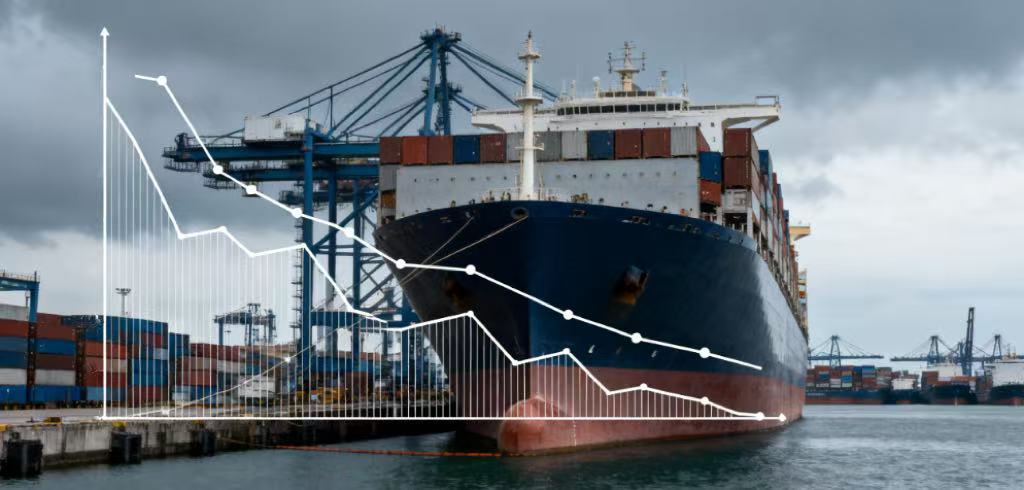Ocean Freight Rates Hit Two-Year Low as Carriers Cancel Record Number of Sailings
Release time:
2025-10-09
Global container shipping is facing another sharp downturn.
For the first time since the Red Sea crisis began, spot freight rates have fallen below most carriers’ break-even levels, hitting their lowest point in nearly two years. In response, carriers are slashing capacity and canceling sailings at record levels to stabilize the market.
1. Market Snapshot: Freight Rates Below Cost, Cancellations Surge to Record Highs
According to Alphaliner, investment bank Jefferies reported that current spot rates on major routes now average just above USD 1,000 per 40-foot container (FEU) — below the estimated break-even level of USD 1,100 per FEU for major shipping lines such as Maersk and Hapag-Lloyd.
In other words, many carriers are now operating at a loss.
Freight rates, which had spiked in late 2023 due to Red Sea disruptions and vessel rerouting, have steadily fallen throughout 2025 as global demand softened and routes normalized.
Current spot rates are the lowest since December 2023.
To counteract this slump, carriers have launched aggressive “blank sailing” programs.
According to Project44 data:
In October alone, 67 sailings were canceled on routes from China to the U.S.;
71 sailings were canceled on return routes from the U.S. to Asia;
Overall capacity cuts exceed levels seen during the COVID-19 pandemic.
“This level of schedule reduction hasn’t been seen since the early pandemic days,” said Bart De Muynck, Chief Thought Leader at Better Supply Chains.
However, this time, the strategy is not a reaction to crisis, but an attempt to protect freight rates in a tariff-distorted market.
2. What’s Driving the Decline: Tariff Volatility, Weak U.S. Demand, and Trade Shifts
The drop in freight rates stems from a mix of macroeconomic and policy factors:
Tariff Uncertainty
With new U.S. import tariffs taking effect in November, many importers front-loaded shipments earlier this year. That rush created a temporary “false peak,” followed by a sharp demand drop.
Softening U.S. Consumption
U.S. imports have declined for five consecutive months, while exports have fallen for nine.
Year-to-date, U.S. imports from China are down 27%, and exports to China are down 42%.
Shifting Trade Patterns
Since the Trump administration, supply chains have been restructured — with part of the volume shifting toward Southeast Asia and Mexico — leaving the traditional China–U.S. trade lane under pressure.
3. Impact: Volatile Rates, Unstable Schedules, Rising Pressure on Forwarders
In the short term, the market will continue to face low rates, high volatility, and frequent blank sailings.
For exporters: lower costs bring opportunities, but unstable schedules increase risk.
For importers: freight is cheap, but delivery timelines are unpredictable.
For freight forwarders: this is both a challenge and an opportunity — shippers now need reliable partners to secure space and maintain supply chain stability.
4. Our Recommendations: Stay Ahead in a Volatile Market
To manage risk and optimize cost under current conditions, we recommend:
Plan Shipments Early
Book space at least 7–10 days in advance to avoid last-minute cancellations.
Diversify Routing Options
Consider both West Coast, East Coast, and Gulf routes to improve schedule reliability.
Lock in Contract Rates
If you ship regularly, this is a good time to secure short-term contract rates while prices remain low.
Work Closely with a Trusted Freight Partner
A reliable forwarder can access carrier allocations, alternative services, and multi-port options to keep your cargo moving.
5. Conclusion: Low Rates = Risk + Opportunity
While the market is challenging, today’s low freight levels also present the best cost window for exporters.
In the coming months, the key to success lies in who can seize this moment of low cost and high uncertainty to prepare for the next market rebound.
📦 Want real-time rate updates or space guarantees?
👉 Contact our team for customized China–U.S. freight solutions — including:
FCL/LCL services from all major Chinese ports to the U.S.
Door-to-door and customs clearance support.
Weekly market rate reports and shipment planning advice.










